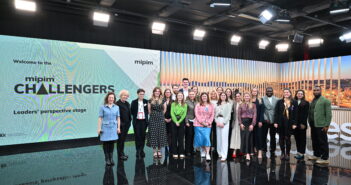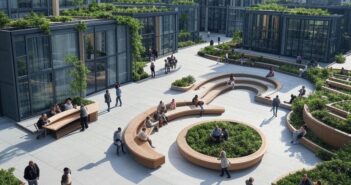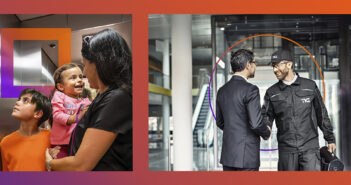“We do need to bring the conversation round to the circular economy in real estate,” Grainger said. “The industry needs to work out ways to reuse and not just recycle materials, creating a viable economic solution that doesn’t add costs.”
Building a circular economy
Described as the ultimate sustainability paradigm, a circular economy is an economic system aimed at minimising waste and making the most of resources. Adopting a regenerative approach both in terms of materials and energy, its methods initially seem far from the requirements of the resource-hungry real estate industry.
Yet, according to Grainger, the property world is starting to wake-up to non-linear production models as it focuses on improving its bottom line, saving the planet, and attracting a Millennial-era workforce which prizes an ethical employer.
“The new buildings of today are being built to a much higher standard than ever before,” he said. “There have been huge improvements, as developers respond to demand, rather than it being enforced through regulation. »
“But the greatest challenge in the built environment remains existing buildings, which need to be repurposed. It becomes a lot more sensible to embrace circular methods when we examine best practises in building refurbishment.”
To date, according to Grainger, “innovations around this type of work have not been scaled. But occupiers are now increasing their demands, and much of this comes from the expectations of the Millennial generation, making it a key element in talent retention.”
The energy paradigm
According to the Intergovernmental Panel on Climate Change, buildings are directly responsible for 6% of global greenhouse gas emissions, while the creation of electricity and heat to power them represents 25% of all global greenhouse gas emissions. In dense, developed economies such as the US and parts of Europe, buildings generate 40% of emissions.
While reducing energy footprints remains a key industry challenge, being tackled in part by the green building revolution, the use of resources is the next frontier, according to Grainger.
“After water, one of the biggest natural resources consumed globally is sand, which is used mostly for cement,” he said. “That’s a huge contributor to carbon emissions, some 8% in total. So developers need to be asking what are the alternatives to cement, and looking at recycling cement. Repurposed concrete can reduce a building’s emissions footprint by up to 70%. Essentially, there are two elements to providing an environmentally friendly building – the first is the construction process, and the second regards the materials you use and how the building is subsequently operated.”
The construction industry
The construction industry is currently a key antagonist to circular economy proponents, as the developed world’s largest consumer of natural and finite resources, and the biggest producer of waste. “One key area which can help is offsite, modular construction,” Grainger said. “This minimises waste and speeds up construction times. As our cities grow, this will be fundamental.
“There’s a stigma attached to modular building from 50 years ago – the prefab – which needs to be removed. The beauty of modular is that it can be scaled efficiently, and with good design, can create brilliant product. Modular also lends itself to forward planning for disassembly, a key argument at the end of a building’s life.”
The circular economy in action
A key issue for the real estate industry is behavioural extremes, according to Grainger. “The property industry is quite disaggregating. Innovation arises in different areas but is not necessarily scaled or adopted uniformly,” he noted. “Particularly in the Western world, we are using more resources than the planet can produce.”
Yet there are a few stellar examples of circular economy in action.
The buildings and landscape at Park 20|20 in Amsterdam, for example, are based on the Cradle to Cradle (C2C) design philosophy, a standard that recognises estates that strive for closed cycles across materials, energy, waste and water. This future-forward business cluster has assembled the world’s largest collection of certified C2C materials in the world, with all buildings connected to the grey water purification system and the park’s own central heat and cold storage installation. Roofs are fitted with photovoltaic cells which convert solar power for the park’s energy needs. Bio-diversity is stimulated by integrating greenery, fresh vegetables and fruit making an attractive environment for bees and butterflies. Every building also has a passport that shows how it can be disassembled.
Meanwhile, the Resource Rows in Copenhagen is a unique and daring residential project forging modular elements cut out from the brick walls of Carlberg’s historical breweries in the city, and upcycling wood from the construction of the Copenhagen Metro to build new homes. This radical approach marries the ethos of the circular economy with the latest sustainable building practises for both the construction stage and the life cycle of the properties.
A flexible future
According to Grainger, the sharing economy offers other clues as to how the property industry can become more circular. “The emphasis in the past has been on the ownership of both the real estate and the fixtures,” he says. “In the future, we will see far more servitisation with partners who provide heating, lighting, and even furniture. There are plenty of organisations out there who provide repurposed furniture, carpets made out of fishing nets, for example. We need to create an environment where we encourage that.”
Meanwhile, aspects of industry innovation, such as flexible offices, also contribute to a more sustainable approach. “Most offices are used just 45-55% even during peak times, which is a waste when they are still heated and lit. Flexible workspaces are one solution, but the data prompts a rethink about how we use space in general.”
Ultimately, a shift towards a circular economy requires a collaborative approach. “We do need strong leadership to prioritise the circular economy because it’s difficult to implement,” said Grainger. “In real estate, we are very reliant on the supply chain of architects, engineers, builders, designers and even the hardware and furniture providers. Every link needs to be thinking laterally about new ways of constructing and operating buildings, which requires a radical shift.”



